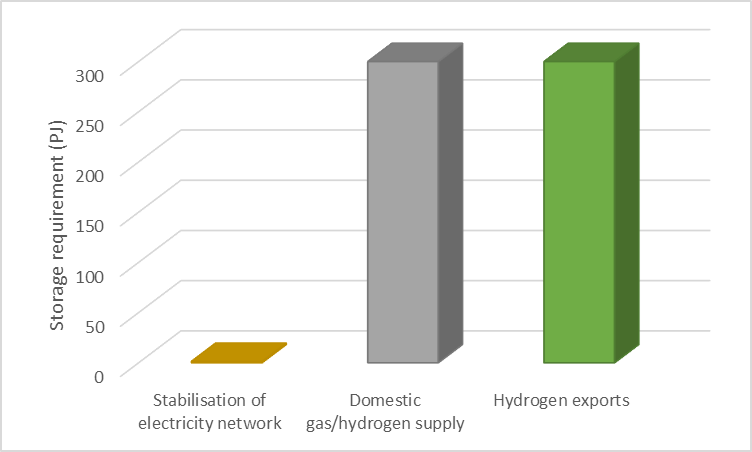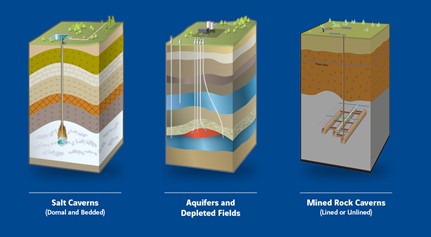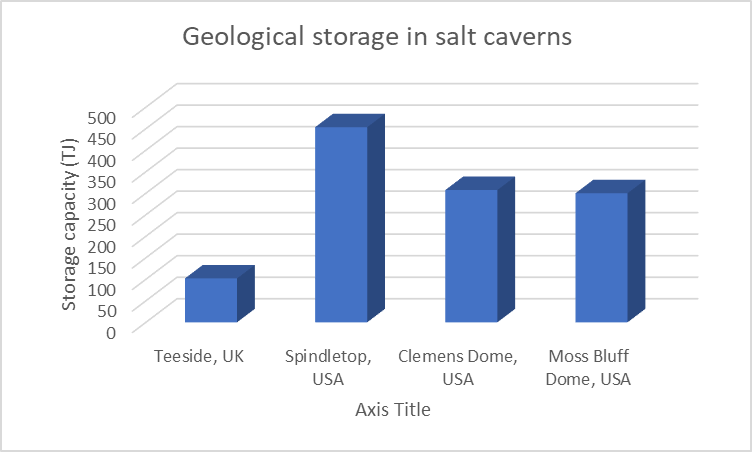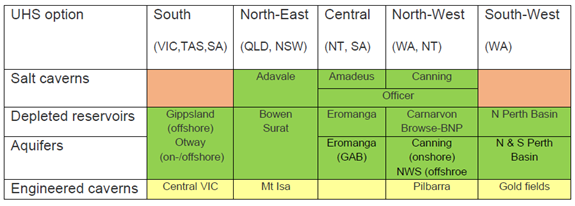Where do you put five million tonnes of hydrogen?
One of the main advantages of gas infrastructure is its ability to store vast amounts of energy. Australia has developed 275 PJ of natural gas storage, which represents more than the combined annual gas consumption for households and businesses[i]. This storage helps balance the daily supply of natural gas with fluctuating demand throughout the day but more importantly, allows seasonal variations in heating demand to be met. This storage is the equivalent of almost six billion household batteries, or around 240 batteries for each Australian[ii]. That’s a lot of energy storage.
As we transition to hydrogen, it is important to understand how much storage capacity would be needed to provide the same level of energy security and whether geological storage can be used.
A joint project between Future Fuels CRC (FFCRC) and CSIRO completed an assessment of underground hydrogen storage (UHS) opportunities in Australia. The aim of the assessment was to estimate the scale of the potential underground storage capacity of hydrogen in sites that are broadly suitable – but not to rank sites from worst to best, which would require further work.
The scale of the storage challenges helps paint the picture. A total storage capacity of just over 600 PJ (about five million tonnes) was estimated. This was made up of 300 PJ for supporting the gas/hydrogen network, 300 PJ to support hydrogen exports and between 1.3 and 1.6 PJ[iii] of hydrogen to support the electricity network if hydrogen is used instead of batteries and/or pumped hydro.
Figure 1: Hydrogen storage requirements (Source: FFCRC RP1.1-04 final report, ENA analysis)
The four main geological storage options for UHS are salt caverns, depleted oil and gas reservoirs, aquifers, and hard rock caverns. Depleted gas reservoirs and saline aquifers are geologically similar.
Figure 2: Underground storage options (source: https://www.entrepose.com/en/geostock-sandia/expertise/)
Salt caverns
Salt caverns can be created in various ways within salt domes or salt deposits by leaching out large cavities through the injection of water. The salt surrounding the cavern is of very low permeability and a very effective barrier to gas leakage. Europe has an abundance of salt deposits so it has focussed on using salt caverns as an option for UHS.
Salt caverns are already used for storing hydrogen for the petrochemical industry.
Figure 3: Operational salt cavern storage sites for hydrogen (Source: FFCRC RP1.1-04, ENA Analysis)
Depleted oil and gas reservoirs
Depleted gas fields have been the preferred options for underground storage of natural gas. These fields are easy to develop and can utilise existing infrastructure (e.g. wells, pipelines). They have also demonstrated containment as they have trapped natural gas over long periods of time. Like gas storage, UHS requires a site with adequate storage capacity, injectivity, and safe containment in the form of an impermeable caprock. Repurposing existing gas storage sites to hydrogen will require assessments of the characteristics and may also require some modification of infrastructure.
Saline aquifers
In regions where the above formations are not available, saline aquifers can be developed for gas storage. The formation should have similar properties as depleted gas reservoirs, such as requiring a trapping structure and having adequate storage capacity and permeability to be able to inject and withdraw hydrogen.
Hard rock caverns
Abandoned mines have been canvassed as an option for UHS. These hard rock areas occur in places where there are no depleted gas fields or saline aquifers. Compressed air storage and CO2 storage have also been proposed for abandoned mines but to date there are no examples of UHS in these mines. New engineered caverns can also be built instead of repurposing abandoned mines.
Storage potential
The total estimated storage potential in depleted gas fields is 37,996 PJ. This is a high-level estimate but not a geological assessment. Converting this to actual storage projects will require more detailed assessments to determine the social or environmental acceptability, the specific location of the sites and much more detailed site assessment and characterisation work.
The key outcome from this initial assessment is that the scale of prospective storage is much higher than the potential demand for UHS of 600 PJ. So only a few sites would be needed in each region.
A qualitative assessment of storage potential for saline aquifers and hard rock caverns was also completed.
As shown below, there are suitable options across all areas in Australia.
Figure 4: Suitability of UHS options across Australia (Source: FFCRC RP1.1-04. Red indicates no suitable options in that basin, yellow indicates possible options and green indicates suitable options).
Figure 5: Underground hydrogen storage opportunities in Australia (Source: FFCRC RP1.1-04).
Economics of UHS
UHS is expected to be the most cost-effective option when the volumes of hydrogen that need to be accommodated are large. The cost estimates can vary considerably depending on the type of storage, the size of the storage option, its location and the level of utilisation.
Future work
The project provided a high-level estimate of the storage potential of UHS. The main finding is that the potential for storage is higher than the potential demand for storage for meeting seasonal gas/hydrogen demand and hydrogen exports.
Implementing UHS in salt caverns Australia requires:
- a more detailed mapping and characterisation of known salt deposits,
- exploration for new salt deposits,
- UHS pilot/demonstration in Australian salt caverns.
For gas fields, the actual capacity, or dynamic storage capacity, would need to be confirmed, initially through reservoir simulations, but ultimately by performing pilot hydrogen injection and production experiments. Specifical aspects to be tested include:
- Amount of cushion gas needed, mixing with residual hydrocarbons
- Interaction of hydrogen with seal – capillary pressure (containment), diffusion, reaction
- Interaction of hydrogen with reservoir – relative permeability, wettability, geochemistry
The capacity to store energy is an essential component of a decarbonised economy to support variable renewable electricity. It is also an important component of a hydrogen export market for Australia to be able to safely store hydrogen. Once again, our unique geography can give us an edge.
[i] Annual gas consumption for households and businesses in Australia is approximately 186 PJ.
[ii] 275 PJ of energy is the same as that contained in 5.66 billion 13.5 kWh household batteries.
[iii] Based on AEMO neutral scenario which requires 350 to 450 GWh of storage by 2040







